OPERATIONS MANAGEMENT
PROJECT MANAGEMENT
Management of a project requires coordinating numerous activities throughout the organization like availability of skilled manpower, timely input of raw materials etc. Project management involves decision making for the planning, organizing, coordination, monitoring and control of a number of interrelated time bound activities. Project Manager therefore, often depends on tools and techniques that are effective enough not only for drawing up the best possible initial plan but also capable of projecting instantaneously the impact of deviations so as to initiate necessary corrective measures. The search for an effective tool has resulted in development of a variety of techniques like Network Analysis.
Network Analysis refers to a number of techniques for the planning and control of complex projects. The two most frequently used forms of network planning are:
- Critical Path Method (CPM)
- Program Evaluation and Review Technique (PERT)
Critical Path Method (CPM):
CPM was developed by Du Pont and the emphasis was on the trade-off between the cost of the project and its overall completion time (e.g. for certain activities it may be possible to decrease their completion time by spending more money- how does this affect the overall completion time of the project?)
In CPM activities are shown as a network of precedence relationships using activity on node construction and it is used for the jobs of repetitive in nature where the activity time estimates can be predicted with considerable certainty due to the existence of the past experience.
Program Evaluation and Review Technique (PERT):
PERT was developed by the US Navy for the planning and control of the Polaris missile program and the emphasis was on completing the program in the shortest possible time. IN addition Pert had the ability to cope with uncertain activity completion times (e.g. for a particular activity the most likely completion time is 4 weeks but it could be anywhere between 3 weeks and 8 weeks).
In PERT activities are shown as a network of precedence relationship using activity on arrow network construction and it is used for non-repetitive jobs (research and development work), where the time and cost estimates tend to be quite uncertain. This technique uses probabilistic time estimates.
The techniques of Critical Path Method (CPM) and Program Evaluation and Review Technique (PERT) are essentially network scheduling techniques used for planning and controlling projects in the field of construction, maintenance fabrication, purchasing and quality control, etc. They employ the technique of minimizing trouble spots such as production bottlenecks, delays and interruptions by determining the critical factors and coordinating various parts of overall job.
NETWORK:
A network is a graphical diagram consisting of certain configuration of ARROWS and NODES for showing the logical sequence of various tasks to be performed to achieve the project objective.
BASIC COMPONENTS:
- EVENT: An event or node is a specific physical accomplishment in a project plan. It is a particular instant of time and does not consume time or resource.
- ACTIVITY: It is a task or item of work to be done, that consumes time, effort, money or other resources. It lies between two events called the preceding and succeeding ones.

In the network construction, the length of the activity may not be proportional to the time duration of the activity. The length and directions of the activity are only symbolic of the time period showing the direction of progress of the activity and the length is so chosen to complete the construction of the network conveniently irrespective of the actual time duration of the activity.
- DUMMY ACTIVITY: An activity which only determines the dependency of one activity over the other, but does not consume any time is called dummy activity. It is represented by dotted line arrow. Dummy activity serve the following purposes:
-
- To maintain uniqueness in the numbering system, as every activity may have a distinct set of events by which the activity can be identified (a dummy activity has a zero time).
-
- To maintain the proper logic in the network.
If two activities have same tail event and same head event with different consumption of time, then in order to maintain the relation we should introduce dummy activity.
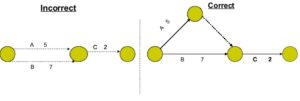
ERRORS IN DRAWING NETWORK DIAGRAM:
There are three types of errors which are most common in drawing network diagram.
- LOOPING: Looping error is also called as cycling error in a network diagram. Making and endless loop in a network is called as error of looping. Cycling in a network diagram can result through trough a simple error or when, while developing the activity plan, one tries to show the repetition of an activity before beginning the next activity. A closed loop will produce an endless cycle in computer programmes with out a built-in-routine for detection or identification of the cycle. Thus one property of a correctly constructed network diagram is that it is non-cyclic.
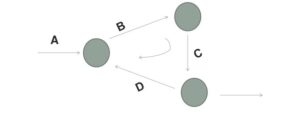
- DANGLING: Whenever an activity is disconnected from the network it is called dangling error. No activity should end without being joined to the end event. If it not so, a dummy activity is introduced in order to maintain the continuity of the system.
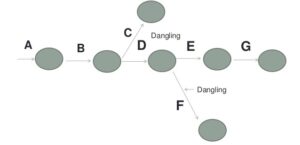
- REDUNDANCY: When the dummy activity is introduced and it is not required then it is called redundancy errors.
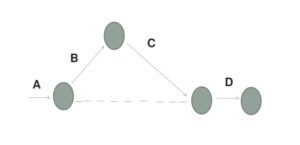
RULES FOR NETWORK CONSTRUCTION:
- Each activity is represented by one and only one arrow in the network.
- All the arrows must run from left to right.
- Dotted line arrows represent dummy activities.
- A circle represents an event.
- Every activity starts and ends with an event.
- No two activities can be identified by the same head and tail event7. Do not use dummy activity unless required to reflect the logic.
- Do not use dummy activity unless required to reflect the logic.
- Avoid Looping and crossing of activity arrows by repositioning.
- Every Activity, except the first and the last, must have at least one preceding and one
succeeding activity.
- Danglers, isolated activities must be avoided.
- For coding use alphabets for all activities including the dummy activity and numbers for
events.
FULKERSON’S RULE FOR NUMBERING THE EVENTS:
After the network is drawn in a logical sequence, every c\event is assigned a number which is placed inside the node circle. The number sequence should be such as to reflect the flow of the network. The rule devised by D.R. Fulkerson is used for the purpose of numbering. The steps are the following:
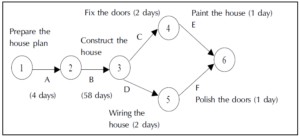
Critical Path Method (CPM) and Program Evaluation and Review Technique (PERT):
- Event number should be unique.
- Event numbering should be carried out in a sequential basis from left to right.
- The initial event which has all outgoing arrows with no incoming arrow is numbered 0 to 1.
- The head of an arrow should always bear a number higher than the one assigned at the tail of the arrow.
- Gaps should be left in the sequence of event numbering to accommodate subsequent inclusion of activities if necessary.
ACTIVITY ON ARROW DIAGRAM AND ACTIVITY ON NODE DIAGRAM:
Both CPM and PERT describe the work plan of project where arrows and circles respectively indicate the activities and events that should be completed to reach the project objectives. The activities and events are laid in a planned sequence of their accomplishments. However,
there are two types of notations used in the network diagram. They are:
1. Activity-on-Arrow (AOA)
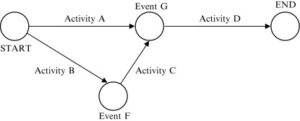
2. Activity-on-Node (AON)
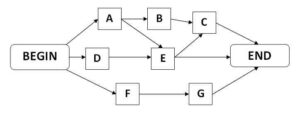
RELATED VIDEOS for Critical Path Method (CPM) and Program Evaluation and Review Technique (PERT) :
